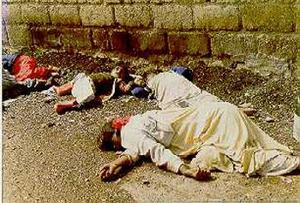Crisis in LibyaU.S. worries Gaddafi may use poisonous gas as chaos deepens
Libya has in its possession 9.5 metric tons of mustard gas, and 650 metric tons of precursor chemicals used for developing chemical agents; in 2003, following the invasion of Iraq, Col. Gaddafi’s government sent to the United States the critical infrastructure for its nuclear-weapons programs, including uranium hexafluoride stockpiles, centrifuge machines, and parts for a nuclear fuel-conversion facility; Libya also destroyed its longer-range missiles and 3,300 aerial munitions used to disperse mustard gas and other chemical agents; the program to eradicate Libya’s chemical agents, as well as its chemical weapons production facility, was delayed by spats between Washington and Tripoli over funding and logistics; “When you have a guy who’s as irrational as Gaddafi with some serious weapons at his disposal, it’s always a concern,” said a U.S. official

Fears Gaddafi may replicate Iraq's Halabja gas attack // Source: uruknet.info
The government of Col. Moammar Gaddafi has not destroyed significant stockpiles of mustard gas and other chemical-weapons agents, raising fears in Washington about what could happen to them — and whether they may be used — as Libya slides further into chaos.
Tripoli also maintains control of aging Scud B missiles, U.S. officials said, as well as 1,000 metric tons of uranium yellowcake and vast amounts of conventional weapons that Col. Gaddafi has channeled in the past to militants operating in countries like Sudan and Chad. The Wall Street Journal reports that current and former U.S. officials said in interviews that Washington’s counterproliferation operations against Libya over the past decade have made gains, in particular the dismantling of Tripoli’s nascent nuclear-weapons program and its Scud C missile stockpiles. The level of instability in Libya, and Col. Gaddafi’s history of brutality, continues to make the U.S. focus on the arms and chemical agents that remain, they said.
“When you have a guy who’s as irrational as Gaddafi with some serious weapons at his disposal, it’s always a concern,” said a U.S. official. “But we haven’t yet seen him move to use any kind of mustard gas or chemical weapon” during the unrest.
The George W. Bush administration reached a key agreement with Tripoli in 2003 that called for Libya to scrap its weapons of mass destruction programs in return for normalized diplomatic relations. The deal followed the toppling of Saddam Hussein and was viewed as a major victory in the push to rid the Middle East of advanced weapons.
Within months of the pact, Col. Gaddafi’s government sent to the United States the critical infrastructure for its nuclear-weapons programs, including uranium hexafluoride stockpiles, centrifuge machines, and parts for a nuclear fuel-conversion facility. Libya also destroyed its longer-range missiles and 3,300 aerial munitions used to disperse mustard gas and other chemical agents. In 2004 Tripoli joined the international Organization for the Prohibition of Chemical Weapons, or OPCW.
The program to eradicate Libya’s chemical agents, as well as its chemical weapons production facility, was delayed by spats between Washington and Tripoli over funding and logistics, according to U.S. officials.
WSJ reports that Libya initially said the U.S. could convert a weapons facility outside Tripoli into a pharmaceutical factory, but then demanded an Italian firm do the work, extending the process. Libya also was reluctant to provide U.S. and British officials visas to monitor the process and cited environmental concerns for the slowed process.
Libya was to have destroyed all twenty-three metric tons of its mustard gas by the end of last year, according to the OPCW, but 9.5 metric tons remain. The Hague-based body said Libya was granted an extension until May to destroy the rest.
Libya also possesses more than half of the 1,300 metric tons of precursor chemicals used for developing chemical agents. The material is believed to be stored in jugs at the former Rabta chemical-weapons facility.
A spokesman for the OPCW said the utility of such chemical agents is lessened without the delivery systems. Officials in Washington said they remain concerned about the security of these materials. They would not rule out the possibility Col. Gaddafi could seek to use them.
“Had the destruction process not started, we would be facing a far more dangerous situation,” said Paula DeSutter, who helped oversee disarmament issues in George W. Bush’s State Department. “On the other hand, one would certainly feel more secure if all of the mustard gas had been eliminated.”
Scud B missiles also remain in Libya. Under Col. Gaddafi’s initial agreement with Washington, Libya agreed it would destroy these weapons only after the United States helped Tripoli upgrade its defenses through the purchasing of other weapons systems. Libya said Washington never made good on its pledge, according to the U.S. officials involved in the discussions.
Libya is also believed to have significant stockpiles of conventional weapons, such as Kaleshnikov rifles and land mines. In addition to supporting Palestinian militant groups in recent decades, Col. Gaddafi has also been charged with shipping arms and funds to militant groups and guerrilla arms operating across Africa.
In 2008 the U.S. Embassy in Tripoli voiced particular concerns that Col. Gaddafi was seeking to import 130,000 of automatic rifles from a British company, according to a diplomatic cable obtained by the Web site WikiLeaks. The United States was particularly concerned because Libya was vague on the end-user for the weapons.
“[The transaction] raises potentially troubling questions about the extent to which Libya is still involved in supplying military material to parties involved in the Chad/Sudan conflict,” reads the cable.
